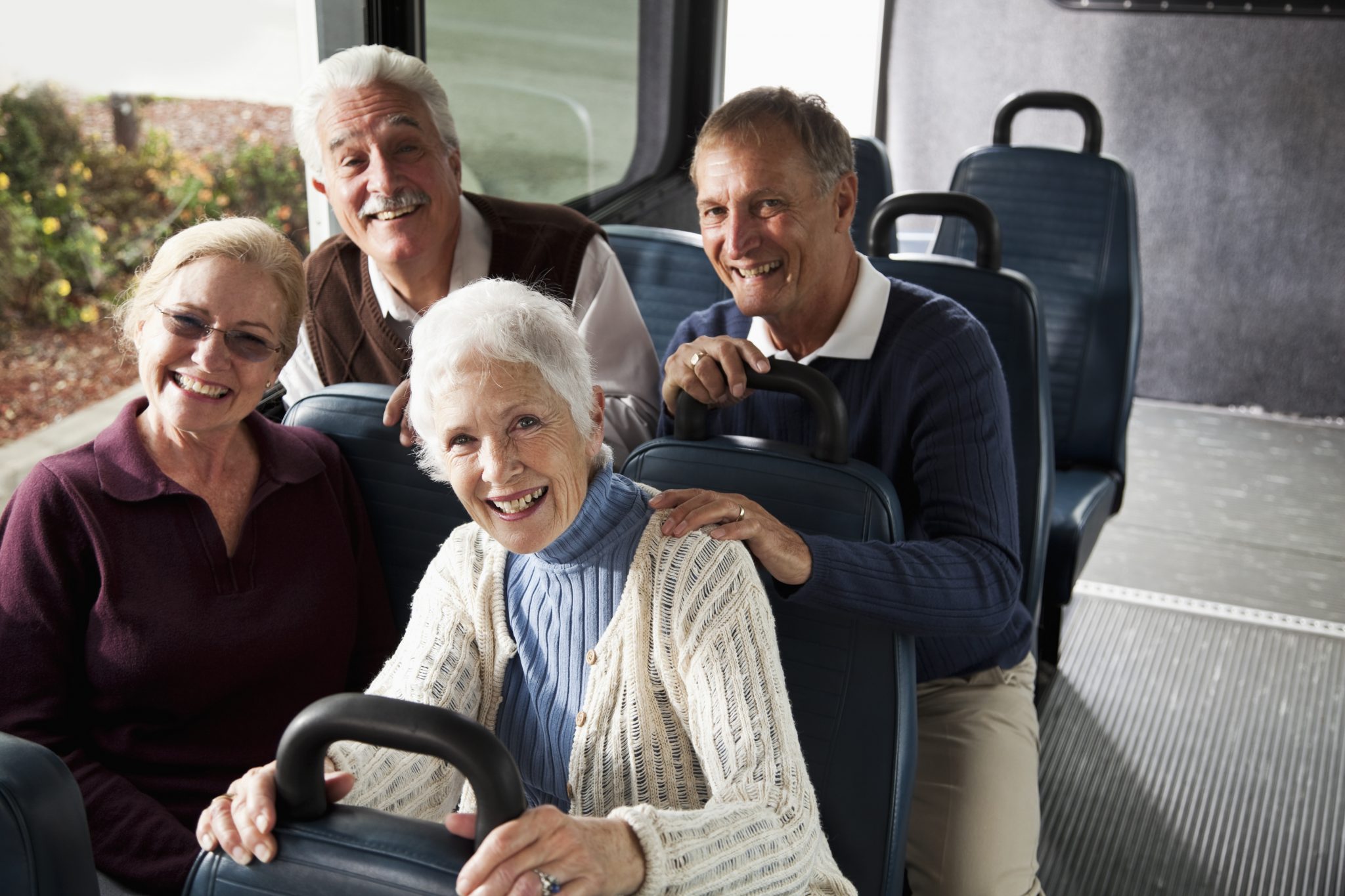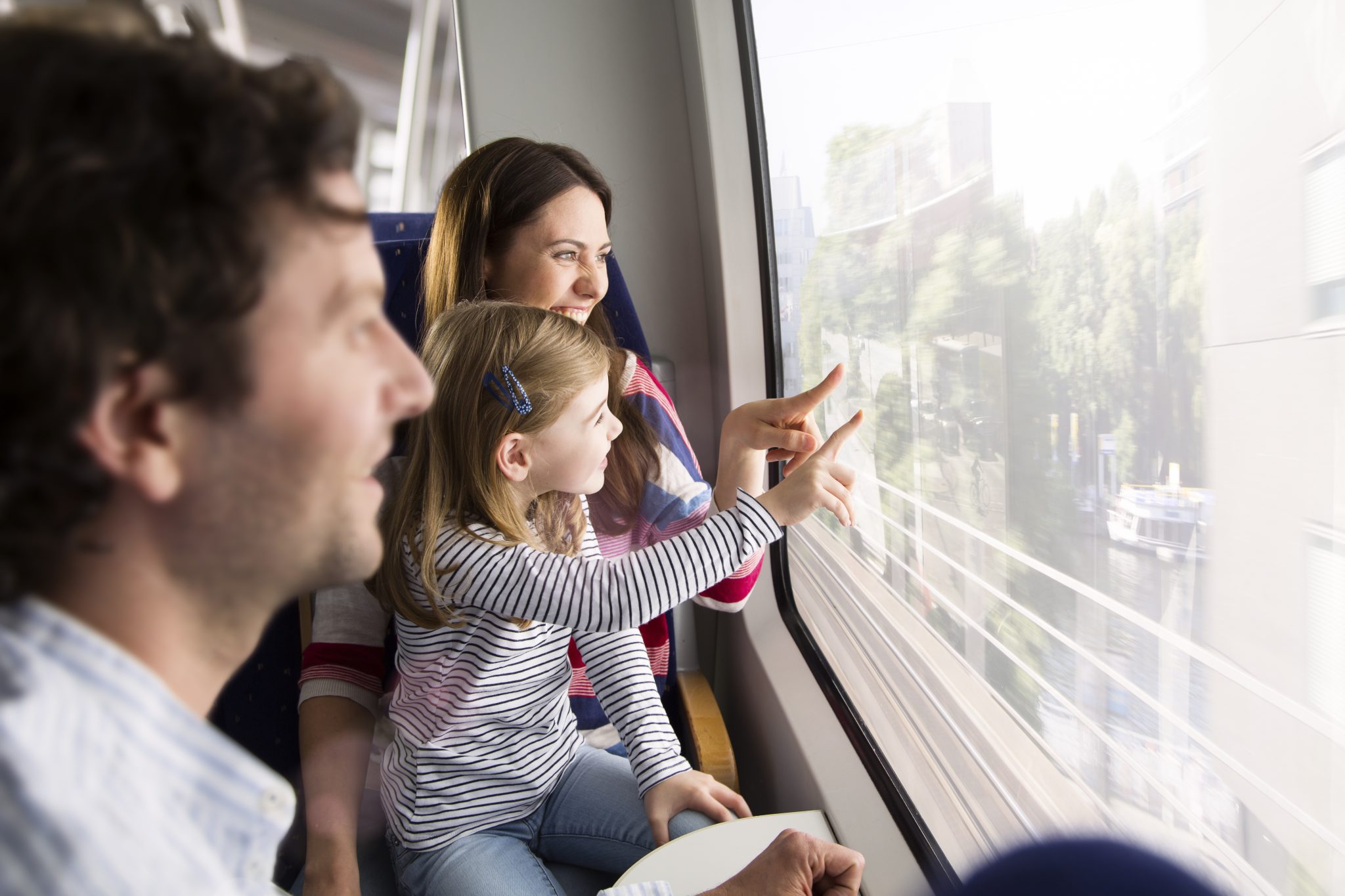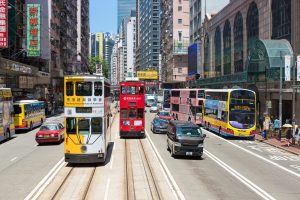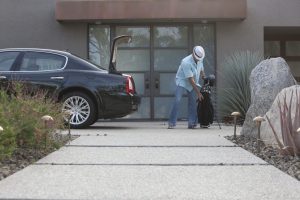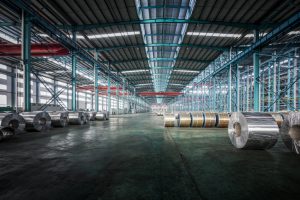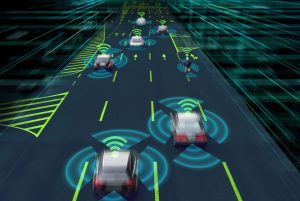1. Introduction
In the last two editions of this column, I examined the hopes and apprehensions people have concerning autonomous driving, and the issues that stand in the way of the widespread adoption of autonomous driving technology, all from the perspective of the end user. This time, I would like to take a broader perspective, and focus on human movement itself.
If I may move back in time a little, Japan’s Ministry of Land, Infrastructure, Transport and Tourism issued a press release in late November 2019 entitled Total Person Trips Decrease for First Time Since Record-Keeping Began. The release was based on data from the Tokyo Metropolitan Area Person Trip Survey, the findings of which included the lowest total number of person trips (instances of travel of any distance by one person using any mode of transportation), lowest home departure rate (the percentage of people who went outside their home on the date surveyed), and lowest number of trips per person per day since the survey was first conducted in 1968.
If Japan is indeed in the process of becoming a society in which people are less mobile, the economic and social effects of that shift will likely be significant. Like some in the Japanese media, I found the contents of the release to be of interest. I would like to begin this column with a summary of the findings of the Tokyo Metropolitan Area Person Trip Survey, before taking a quantitative look at the circumstances that surround mobility.
2. Circumstances Surrounding Mobility in Japan
The survey’s most noteworthy findings were that the total number of person trips had gone down for the first time since the survey was first conducted, and that both the home departure rate and the number of trips per person per day were the lowest in the survey’s history (as shown by the figures highlighted by red arrows in the graph below and to the left). The home departure rate decreased for all age groups, and the number of trips for personal purposes such as shopping, dining, socializing, and entertainment fell markedly from 2008 to 2018 (as shown by the figures highlighted by red arrows in the graph below and to the right). Do the people you know also seem to go out less often than they did in the past?
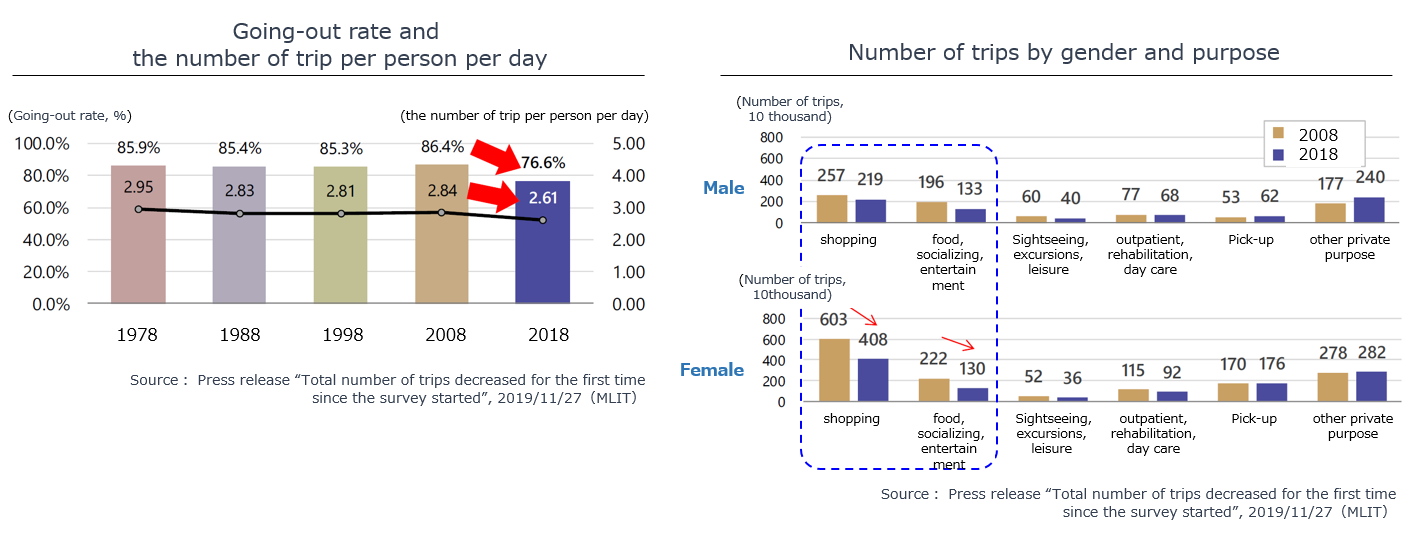
One of the factors believed to be behind the decreasing rate at which people are going out is the increased use of the internet. With smartphones and home computers being connected to the internet, it has become not just possible, but commonplace for people to shop, order food, and do many other daily activities without leaving home.
The graph below and to the left shows the changes over time in the number of parcels delivered to homes and the percentage of households that use online shopping, illustrating the considerable pace at which online shopping is becoming more common. Needless to say, this rapid change is having an enormous impact on the shipping industry. The graph below and to the right shows the change in the average amount of time per day that people spend using the internet on mobile devices. We can see that on average, people spend roughly twice as much time doing so as they did five years ago. A person who has a smartphone can shop, connect with friends and family on social media, and partake in forms of entertainment such as movies, music, and games at any time, so they may have less incentive to actively take the step of leaving their home.
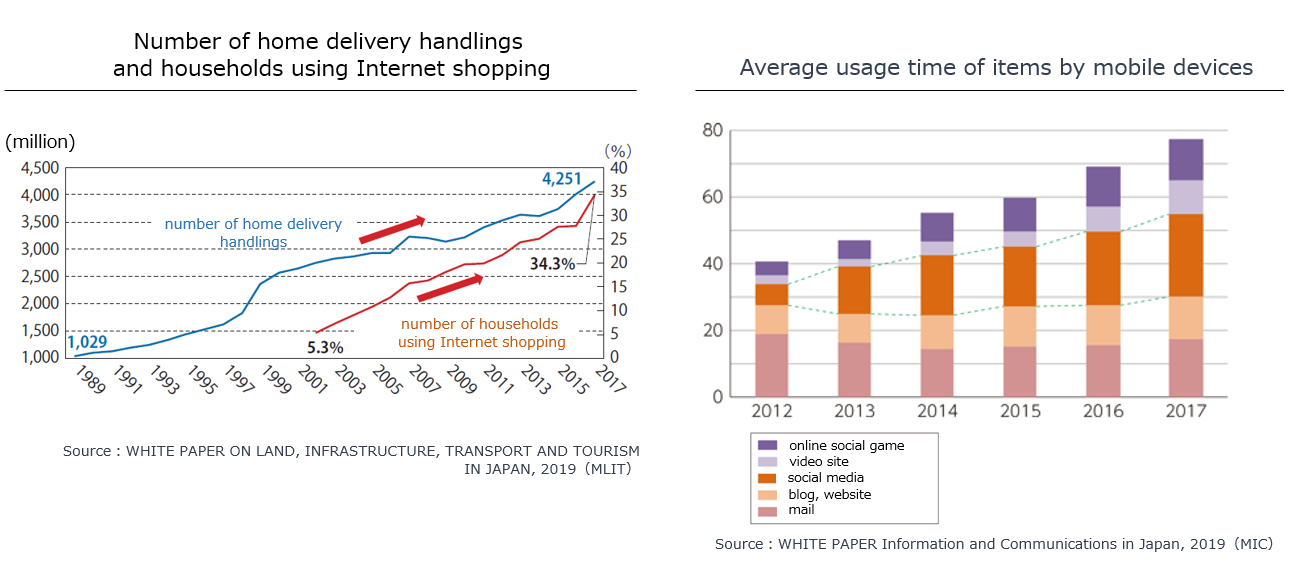
The graph below and to the left provides an overview of the results of a study on the changing size of the food delivery market. Spurred on by the emergence of online food delivery services such as Uber Eats as well as trends such as the diversification of lifestyles and the aging population and declining birthrate, we can see that the demand for home delivery of meals and packaged foods is growing steadily. By the same token, it should come as no surprise that the market conditions for restaurants have become increasingly harsh. 799 businesses in the food service industry went out of business in 2019. In the 20-year period from 2000 to 2019, the only year that saw a higher figure was 2011, at 800 (see the graph below and to the right).
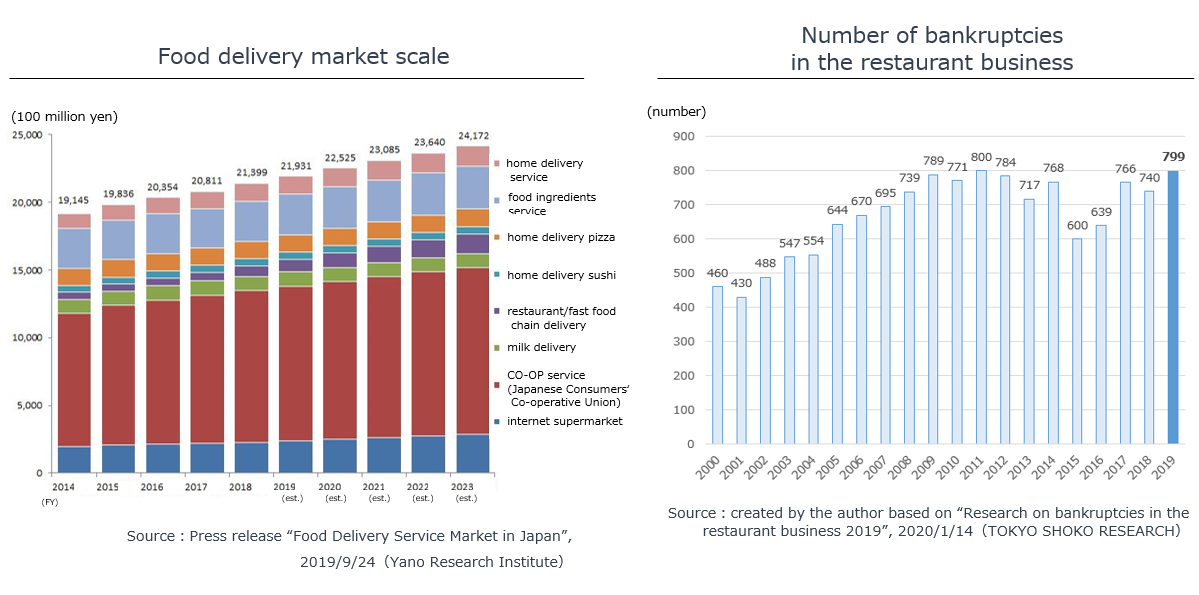
Now, I would like to take a step back and look at the circumstances surrounding mobility. The graph below shows the changes in the yearly distance traveled by vehicles of different types in Japan. Looking at the 20 years since 2000, the total distance traveled by automobiles (shown in blue) has begun to shrink, with its peak coming in 2005. The figure for 2019 is roughly 17 percent lower than that for 2005. During that same period, bicycle and motorcycle mileage (shown in red) peaked in 2001, with the 2019 figure representing a drop of approximately 32 percent from 2001. Thus, the issue of declining mobility can also be seen in terms of the distances people are traveling.
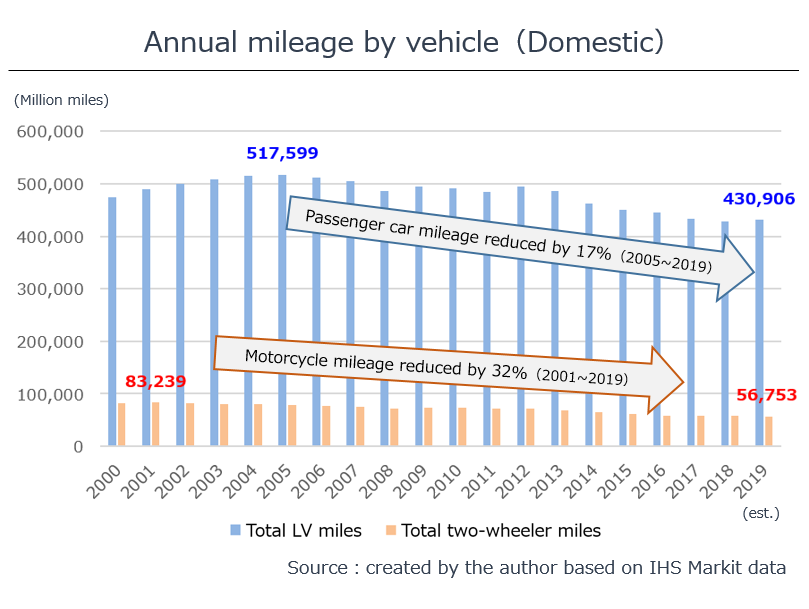
To this point, we have taken a brief look at the findings of the Tokyo Metropolitan Area Person Trip Survey and the circumstances surrounding mobility in Japan.
To round out our background information, I would like to take a look at the situation facing the transportation service providers that offer people ways of moving from one place to another. The graph below and to the left shows the ridership numbers for passenger buses (including fixed-route buses and intercity express buses) and other related figures. We can see that while ridership and revenues have grown somewhat in large cities that have seen population increases (as shown in blue), the demand for transportation still continues to fall, and the circumstances surrounding passenger buses remain challenging. The graph below and to the right shows the changes in the number of people transported by taxis and other hired-car services, along with the number of vehicles used by said services. As the graph shows, these services also continue to face challenging conditions.
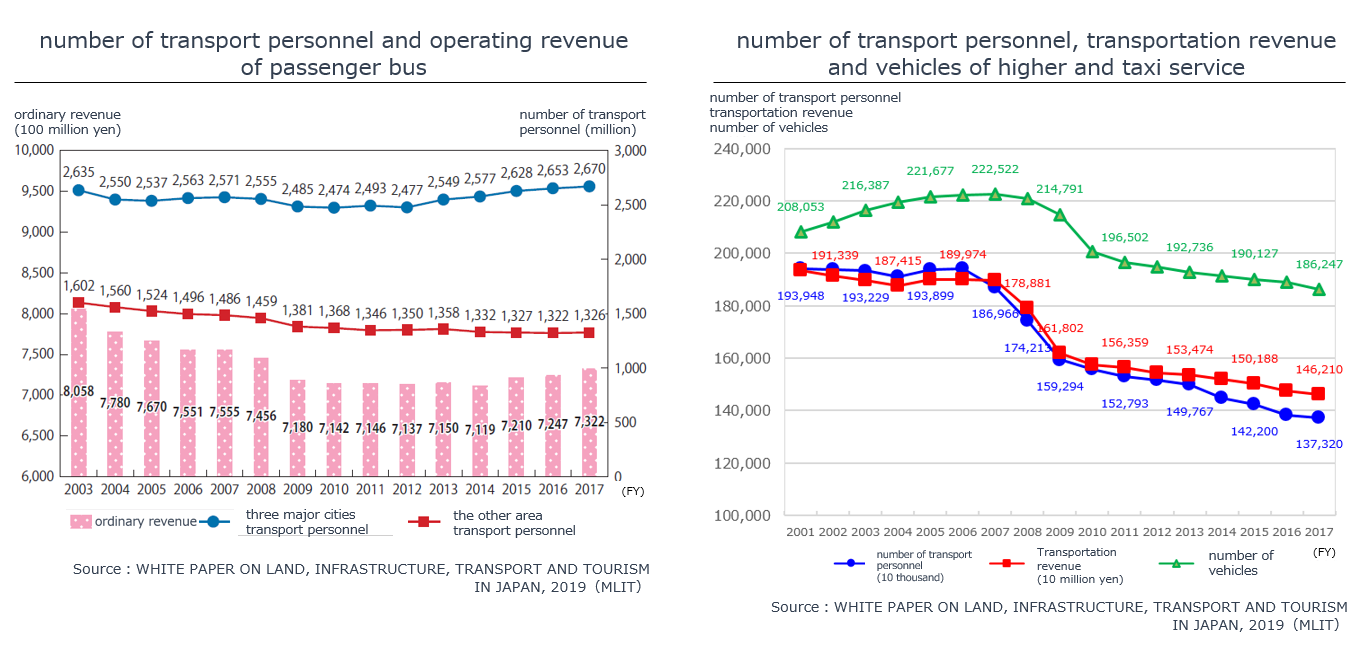
3. Designing Services That Add Value to Mobility
The point of my long preamble was to examine Japan’s transformation into a decreasingly mobile society through the lens of the numbers that have been uncovered by several different studies. When we take into account the effects of mega-trends like the country’s declining birthrate and aging, decreasing population, we can perhaps take the view that demand for the transportation of people will continue to decrease into the future.
I would like to take this opportunity to consider once more the value of movement. Given that moving is not an end unto itself, but a means of getting to a destination, mobility has provided value to the user in helping them reach their destination more quickly, more affordably, more comfortably, and more conveniently. For that reason, transportation service providers have sought to differentiate themselves along the lines of speed, affordability, comfort, and convenience.
However, with figures such as total person trips and home departure rate now decreasing in Japan, companies that try to build a competitive edge using only the methods of the past could very well find themselves in an industry-wide war of attrition for an ever-shrinking number of passengers. Therefore, for the remainder of this column, I would like to try to advance the point of view that if end users can discover new added value in “moving” (something that up to now has only been a means to an end), they would have more reasons to go out, and would find greater enjoyment in the act of moving itself, which in turn could result in greater demand for transportation.
Having thus far served only as a means to an end, can mobility do more? I would like to offer a few brief examples of how mobility can deliver new added value to users and facilitate the creation of new user experiences. (For more information, please refer to the provided reference links.)
•Beauty Taxi: Mobility Meets Makeup (Beauty Taxi N1, Russia)
The first example I would like to offer is this mobile beauty salon for women. This service addresses the concerns of women who might otherwise hesitate to go out because of the time and effort associated with putting on makeup, and meets their needs by providing the services of a professional makeup artist, all during the time spent in transit to the destination, thus providing new value by using travel time to help users look their best. At the link below, you can see a video of one user’s experience with this service.
(Reference: Reuters )
•Happy Maps: Mobility Meets a Map App That Chooses the Most Entertaining Route (GoodCityLife, United Kingdom)
This service suggests travel routes with good scenery, making users’ trips more enjoyable. By going against the grain of prioritizing ever-quicker arrival at the destination, Happy Maps has differentiated itself from conventional route search apps and car navigation systems, which have taken the approach of directing users to the shortest possible route. When users are empowered to choose the most scenic or least busy route for that time of year or time of day, they may find more reasons to go out and move.
(Reference: GoodCityLife )
•nommoc: Mobility Meets Free (nommoc, Tokyo)
I suspect that many of my readers in Japan will already know about nommoc, a car service that offers free transportation to the user’s destination, with the goal of transforming the act of traveling into a new experience. The user can request a ride through a smartphone app, and enjoy content created by nommoc’s advertising partners during the trip. This service challenges the conventional wisdom that states that travel must come with a cost. When people can travel without having to think about what it will cost, they may find themselves having a longer list of places to visit.
(Reference: nommoc Inc. )
•HorroRide: Mobility Meets VR Entertainment (Synesthesias, Tokyo)
The next example is a form of driving-based entertainment that uses virtual reality technology. Animated characters appear in the passengers’ field of vision to engage them in conversation and serve as sightseeing guides for a variety of locations. Synesthesias also develops VR activities that interact with the movement of the vehicle and the surrounding environment within zones that are procedurally generated from 3D maps, route information, and other data used by autonomous driving systems. The company’s technology may even make it possible for riders to travel back in time and experience first-hand the history of the neighborhoods they are traveling through.
(Reference: Synesthesias, Inc. )
•Dream Sleeper: Mobility Meets Private-Room Accommodations (KANTO Bus, Tokyo)
Finally, this intercity express bus service is the first in the industry to offer a private room for every passenger. Aboard the bus, passengers will find 11 rooms in total, each with its own door. The result of KANTO Bus’s pursuit of high-quality relaxation and the ultimate sleeper experience, the Dream Sleeper bus is furnished with hotel-style amenity items such as loungewear and aromatherapy products. This service delivers new value in the form of accommodation in a private room for the duration of a long-distance trip, distinguishing itself from conventional express bus services. Free Wi-Fi is also available, giving business travelers the option of using Dream Sleeper as a mobile office.
(Reference: KANTO Bus Co., Ltd. )
4. Conclusion
If the act of moving is made to be more enjoyable, as the services I have presented here have done by adding value to mobility, we can expect that people will feel more motivated to go out. It would also be likely to help generate more demand for transportation. Here in Japan, with our decreasingly mobile society, building demand may be no simple task. However, my hope is that putting a greater number of appealing means of transportation within users’ reach will give them more reasons to travel, and more opportunities to enjoy a variety of delights at more destinations in the physical world that are not available on the internet. If that happens, then I am certain that destination communities, neighborhoods, and establishments will also become that much more appealing.
If I may turn my attention to the future for a moment, I believe that the use of autonomous driving technology will lead to “means of transportation” being redefined as “mobile spaces.” People are believed to spend an average of 300 to 400 hours in transit every year. When we understand the spaces in which people do that traveling as a new market, I feel that for transportation service providers that are looking to demonstrate a competitive edge going forward, it will be important to not only continue to provide speed, affordability, comfort, convenience, and the other established, functional forms of value, but also to find ways to deliver added value that brings stories and significance to movement, as the companies I have listed here as examples have succeeded in doing. Those of us in the industry will continue to endeavor to develop greater insights into society and technology, and to create and implement the services users want.
